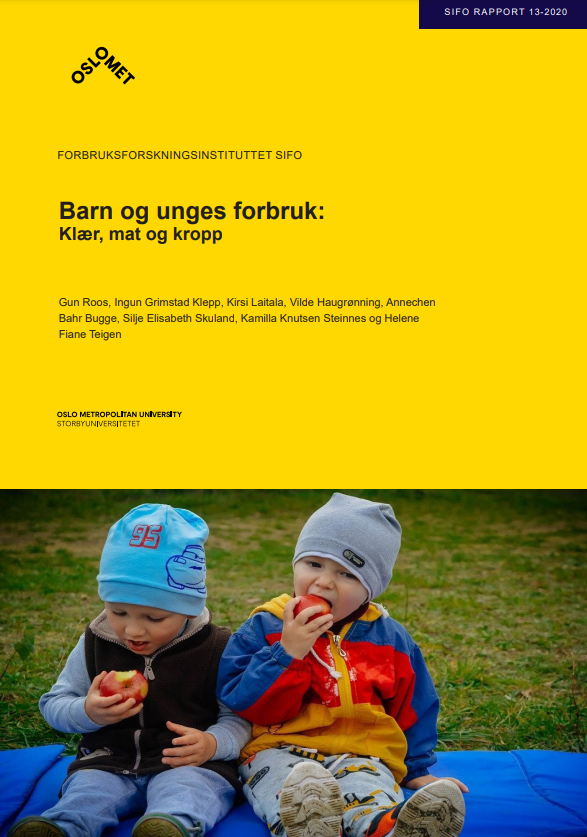Barn og unges forbruk: Klær, mat og kropp
Bahr Bugge, Silje Elisabeth Skuland, Kamilla Knutsen Steinnes og Helene Fiane Teigen
Sammendrag
Denne rapporten, som i hovedsak er basert på en spørreundersøkelse om barn, klær, mat og kropp blant foreldre med barn i alderen 1-16 år, beskriver barn og unges forbruk av klær og mat og hvordan de forholder seg til kropp, helse og miljø. Undersøkelsen viser at mange foreldre gir klær til gjenbruk, men en mindre andel sier at deres barn bruker brukte klær. Spesielt klær blant de yngste barna går i arv. Det er vanlig å reparere barneklær selv, men uvanlig å betale andre for det. De færreste foreldre svarer at barna går med halvskitne klær, men helse og miljø fremstår ikke som spesielt viktige for foreldre når det gjelder klesvask. Det er delte meninger om og erfaringer omkring spørsmål om klær, klesnormer, kjønn, kjøpepress og religion. Hovedansvar for barns klær har mødrene eller ansvaret deles likt mellom foreldrene. Barn og unges meninger om klærs betydning for inkludering og erting er delte, det samme gjelder skoleuniform som mulig løsning. De er mer positive til dette tiltaket enn foreldrene. Resultatene viser at det mangler kunnskap om hvordan vi kan kle barn slik at de får en sunn, trygg og god barndom og hvem som har ansvar for at det skjer.
De fleste barn og unge rapporterer et mat- og spisemønster som er i tråd med ernæringspolitiske målsettinger. Tilgjengeligheten hjemme av sunne matvarer er høy i barnefamilier og tilgjengeligheten av usunne matvarer er lavere, men en av ti sier at de alltid har usunne matvare hjemme. Tre av fire foreldre sier at deres yngste barn spiser matpakke hver dag på skolen, og mange er enige i at matpakka bør erstattes med et skolemåltid. Behovet for å erstatte matpakka med et skolemåltid er størst blant foreldre i de laveste inntekts- og utdannelsesgruppene, og for foreldre som oppgir at barna deres ikke spiser matpakke daglig på skolen. Foreldre synes at det i stor grad er den enkeltes ansvar å spise sunt, men at også myndighetene har ansvar. Mange foreldre er enige i at myndigheter bør benytte seg av prisvirkemidler og at markedsføring og reklame av usunn mat til barn bør forbys. Barn og unge uttrykker både tilfredshet og misnøye med egen kropp og utseende. Ungdommer, jenter oftere enn gutter, gjennomfører en rekke skjønnhets- og kroppspraksiser regelmessig. Det er vanlig blant unge å unngå mat som allment anses som usunn.
Klikk her for å lese hele rapporten (oda.oslomet.no).
Summary
This report, which is mainly based on a survey about children, clothes, food and the body among parents of children aged 1-16 years, describes children’s and young people’s consumption of clothing and food and how they relate to the body, health and the environment. The survey shows that many parents give clothes for reuse, but a small proportion say that their children wear used clothes. Especially clothes among the youngest children are inherited. It is common to repair children’s clothes yourself, but unusual to pay others for it. Few parents answer that their children wear half-dirty clothes, but health and the environment do not appear to be particularly important for parents when it comes to laundry. There are divided opinions and experiences about questions about clothing, clothing standards, gender, buying pressure and religion. The main responsibility for children’s clothes lies with the mothers or the responsibility is shared equally between the parents. Children’s and young people’s opinions about the importance of clothing for inclusion and teasing are divided, as is the school uniform as a possible solution. They are more positive about this measure than the parents. The results show that there is a lack of knowledge about how we can dress children so that they have a healthy, safe and good childhood and who is responsible for it happening.
Most children and young people report a food and eating pattern that is in line with nutritional policy objectives. The availability of healthy foods at home is high in families with children and the availability of unhealthy foods is lower, but one in ten says that they always have unhealthy foods at home. Three out of four parents say that their youngest child eats a packed lunch every day at school, and many agree that the packed lunch should be replaced with a school meal. The need to replace the packed lunch with a school meal is greatest among parents in the lowest income and education groups, and for parents who state that their children do not eat packed lunches daily at school. Parents think that it is largely the individual’s responsibility to eat healthy, but that the authorities are also responsible. Many parents agree that the authorities should use pricing instruments and that marketing and advertising of unhealthy food to children should be banned. Children and young people express both satisfaction and dissatisfaction with their own body and appearance. Adolescents, girls more often than boys, conduct a variety of beauty and body practices regularly. It is common among young people to avoid foods that are generally considered unhealthy.
The full report is only available in Norwegian.
